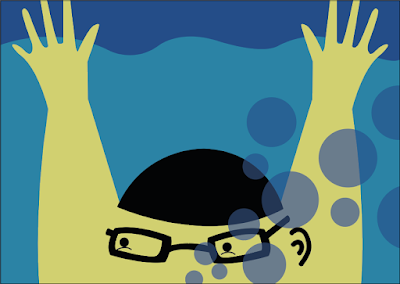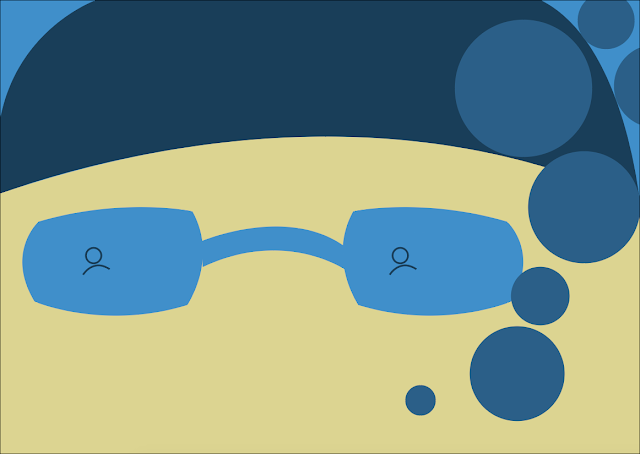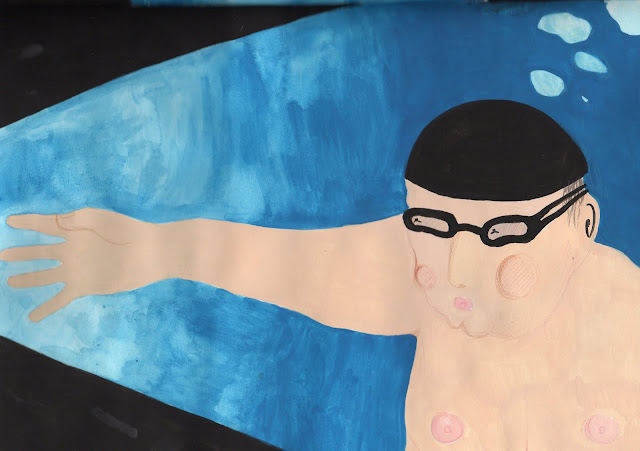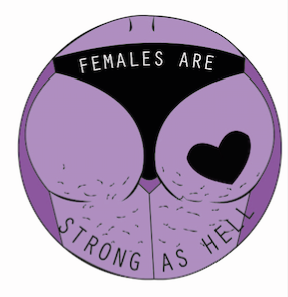This module has most definitely had its ups and downs but I can safely say that its been my favourite of the year. The beginning saw us getting stuck into character design which was something that I thought I was already well practised at, but the fact we were given a random song we had to relate the character to made it that much more challenging. I was given a song called ‘Please’ by Blanck Mass which was really not something I’d ordinarily listen too, but I still really enjoyed just taking time to sit and listen to the little parts and pick it apart to try and find a character in there. I ended up making my character a space yeti called Richardo who I have become way too attached too over the last few months, one of the hightlights of this project was the amount of time we were allowed just to get to think our characters personality through and get to know them. I feel like this really helped me when it came to animating the way he would move. Before this module GIFs were an alien and terrifying concept to me, which I’d seen but had no clue how they even worked, but I went in a little bit too determined to learn something new as I feel like I’ve been lazy and stuck my head in the sand before when its come to learning new digital things. Now I can see what a valuable skill this is too have and I 100% think that I’ll be making more GIFs in the future as they really helped make my character that extra bit more three dimensional. They can still be a little bit frustrating because I think they need more accuracy and attention to detail than just drawing but now I know the process its a lot less scary. I also started to feel like a lot more of my personality was coming out in my character designs and especially in Ricardo.
The sticker brief of the project was my favourite, even if it was daunting at first. The brainstorming and roughing part of this brief was some of the best times I think I’ve had on this course so far as it really made me realise how many things I care about and how I can use illustration as a platform to talk about those things and make them visual so that they can be understood by more people. I ended up going with a few ideas centred around catcalls, body positivity and not being a dick, all of which I talk very passionately about. Making the final sticker on Adobe Illustrator is something I’ve never done before but thought I’d really struggle with as I often find it hard to see the logic in digital processes, however learning how to use Ai in this module has literally changed my practise for good. I don't know why I feel so differently about Ai than I do about photoshop, maybe its using vectors or the freedom you can have with it? Either way I find it so satisfying and simple to use and I think I’m using it well enough now that you still get a sense of my hand of the maker through it, it still looks like something that was made by me. We also had to stick to a two colour palette for the stickers which is something that at first I used to really struggle with but now I can see that it helps to give the work more of a focus and look a bit more professional. I made my stickers black and purple and ended up going with the body positivity theme, it was during this brief that I realised I could see myself making things like this for real in the future.
The final brief was defiantly the hardest and I don't just think it was because it was nearing the end of term. I did mine on Yoshiro Nakamatsu, a Japanese inventor and all round crazy person, who I’ve really come to love. But at first I found the research element to the project really hard, even though I’m someone who has always thought I’m quite good at doing extensive research. I think the reason I disliked this brief so much at first was that it felt eerily similar to visual narratives which was really challenging and was mostly self led, and compared to the first two briefs of this project which has been quite restrictive and had a clear direction it all felt really daunting. Its not that I don't like choosing how I lead the project, I really like deciding which parts I’ll choose to focus on and which media and colours to use, its just that in a project like this one where we only had three weeks to research, develop and make, it felt like we had to make a lot of decisions in not a lot of time, and in that situation I’m always scared I’ll focus on something rubbish then only realise when its too late to change it. Luckily we had a lot of crits and feedback sessions which I found immensely helpful, I think when I spend too much time with a project my head becomes a bit cloudy and I struggle to see if what I’m making is any good. I started by playing around with gouache and whilst I was really enjoying the process it felt pretty tedious having used more digital methods for the last few projects. I struggled to come to terms with this change in myself during crits and on my blog, as a lot of people seemed to really like the use of wet media, I just wasn't enjoying making things with it. So I decided to start translating some of the sketches I’d worked up into Ai, this took a while at first and the first few looked horrendous, but after a few goes I found my feet, and felt I was able to put my own spin on the process and make it look my own. I did really enjoy portraying Nakamats in this way
even if I found it hard at first, I think what I’ve learnt from this is that in a similar way to narratives, I need to focus on smaller areas of information during research, and to make what I enjoy creating, because overall thats what I’ll be motivated enough to continue with and learn the most from.
Overall this has been the module where I have begun to feel most like a real illustrator and there are so many reasons for this such as the sheer amount of hours I worked on the things I was creating, I was working from 9 to 6 every day and feeling really great about it because I could rest easy knowing that I’d put all the effort I could into it, but also it was easy because I was enjoying it. Theres also the fact that I got to put a lot more of myself into the briefs, which I have come to learn from this and the other briefs isn’t a bad thing. Its driven me to be more passionate and involved in the process, as well as more in touch with myself and how my practise makes me feel. Its also led to me finding out how to use some valuable processes which I know I’ll use again, without this brief I might not have found out how to use Ai, and although I know I cant rely on it for everything, I think it has greatly helped me in simplifying my practise where I used to needlessly over-complicate things. I’m leaving this module behind, feeling both sad and relieved that its over, but excited to put more of myself into my practise and get stuck into the next project as much as I have into this one.



































